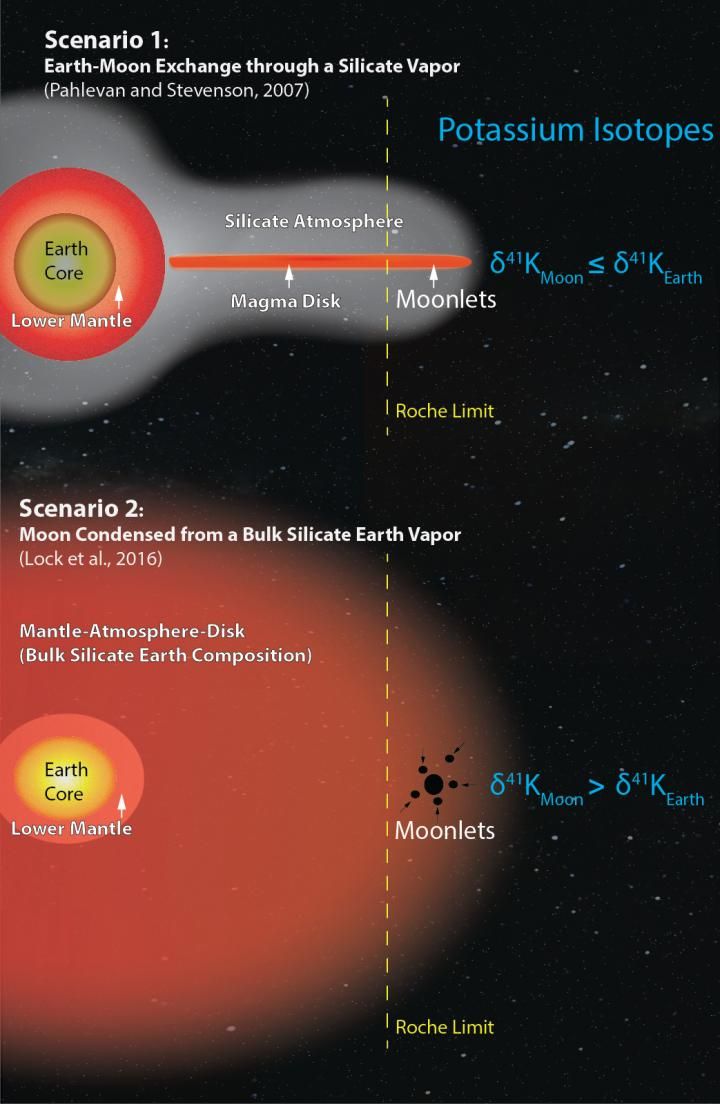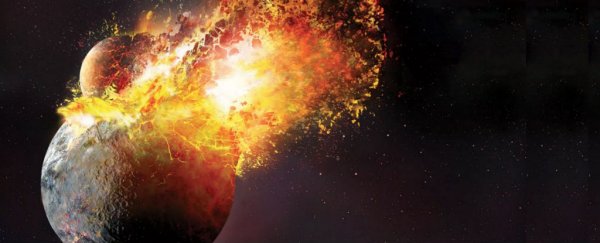For decades, scientists have been debating what it would have looked like when a chunk of Earth broke off and formed our Moon some 4.5 billion years ago.
And now new chemical evidence suggests that things were way more violent than we'd assumed, with researchers suggesting that the impact that set our Moon free was "like a sledgehammer hitting a watermelon".
It's well-established that the Moon was once a part of Earth before it was sloughed off the side and thrown into our orbit, but the circumstances in which this 'great uncoupling' occurred has been a topic of heated debate.
Until recently, the most widely accepted hypothesis for how the Moon was formed suggested that a Mars-sized object (sometimes called Theia) once collided with the still-developing Earth, about 20 to 100 million years after the Solar System first came together.
While our young planet appears to have come out of the collision fairly unscathed, the impact would have caused Theia's core and most of its mantle to sink into and merge with Earth's own core and mantle.
Of the remaining dust and debris that were ejected into Earth's orbit, a small accretion disc was formed, and from this, our Moon eventually took shape.
While this encounter might sound pretty violent, the consensus among scientists for almost five decades has been that Theia made a fairly low-energy graze across the surface of Earth.
This hypothesis, known as 'the giant impact', went on to explain all kinds of other things - such as the large size of the Moon relative to Earth, and their separate rotation rates - and there's a whole lot of evidence to support it.
But there was always one big problem with this hypothesis. It would make sense that a large portion of the material that makes up the Moon would have come from Theia, but chemical analyses on samples brought back by the Apollo missions in the 1970s indicated that Earth and lunar rocks were nearly identical.
Simulation after simulation of the impact predicted that most of the material (60 to 80 percent) that formed the Moon would have come from the impactor, rather than from Earth, and it was extremely unlikely that Earth and Theia had the same chemical make-up.
Fast-forward to now, and geochemists from Harvard and Washington University are reporting that a new, more detailed analysis of seven Moon rocks and eight Earth rocks didn't clear things up like they were expecting - it actually blew the giant impact hypothesis right out of the water.
"We're still remeasuring the old Apollo samples from the '70s, because the tech has been developing in recent years," one of the team, Kun Wang from Washington University, told Ria Misra from Gizmodo.
"We can measure much smaller differences between Earth and the Moon, so we found a lot of things we didn't find in the 1970s. The old models just could not explain the new observations."
In fact, not only did the new analysis find no new evidence of materials that could have come from something other than Earth - it actually suggested that the origins of these Moon rocks were even more tightly bound to Earth than we thought.
And there was another neat little detail in there. Every single isotopic signature in the chemical analysis matched up to both Earth and the Moon, except for one: heavy-potassium isotope in the lunar samples.
In order for this heavy-potassium isotope to appear separately in the lunar rocks, they must have sustained some incredibly hot temperatures, and from this, the team suggests that the Moon-forming collision was a whole lot more violent than we could ever have imagined.
As Loren Grush explains over at The Verge:
"The collision that formed the Moon wasn't low energy at all, [Wang] argues. Instead, the impact was extremely violent, pulverising most of Earth and the impactor, and turning them into a vapour.
In this scenario, the vaporised Earth and impactor mix together into a giant dense atmosphere. This atmosphere then cools and condenses into our planet and its satellite."
It's an incredibly bold claim, because not only does it suggest we were wrong about how our own Moon formed, but it paints a picture of a far more violent and volatile early Solar System than we thought.
While no one's come out to dispute the claims outright, the onus is now on Wang and his team to make their hypothesis more convincing and weighted in evidence than the one we've been carrying around for almost 50 years.
And that involves demonstrating how seven lunar samples high in heavy-potassium isotope can accurately represent the Moon's overall potassium composition.
"I'm very pleased overall with what they have done, I just wish they had used better samples," Munir Humayun, a geologist at Florida State University who was not involved in the study, told The Verge, adding that there's not enough data to support the hypothesis just yet.
Wang himself doesn't seem too fazed by the criticism, saying every new hypothesis takes time to settle in and become accepted as the evidence mounts around it.
"It took people decades to accept this giant-impact hypothesis," he says. "Now we're saying that [the] giant impact hypothesis is not right, so it may take 10 to 20 years to accept the new model."
Only time will tell if his version of the Moon origin story will hold up to scrutiny.
The study has been published in Nature.
 Wang et. al.
Wang et. al.
